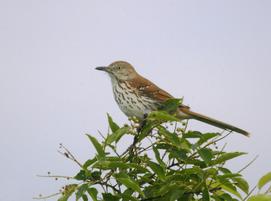BROWN THRASHER VA-30
Appalachia: Breaks Interstate Park and vicinity, far western Virginia
May 6, 6:18 a.m.
Sunrise at 6:31 a.m.
Just a few yards overhead, a brown thrasher runs through five minutes of his good stuff. As song after song drops down to my ears, each one different from the others, I can well imagine that he has a few thousand different songs that he can sing.
Knowing that some brown thrashers are good mimics, I listen carefully, trying to pick out what he might have pilfered from other species, and come up with a list of which I'm fairly confident:
0:33, song sparrow (just the last trill of a song)
0:44, Carolina chickadee song (hi-lo-hi partial song)
0:52, American goldfinch
1:25, Carolina chickadee call
2:01, female red-winged blackbird
2:22, Carolina wren
2:25, northern flicker wik-wik-wik song
2:33, northern cardinal single song syllable
2:42, Carolina chickadee song, again
3:31, tree swallow?
4:52, American goldfinch?
Had he the inclination to sing here for a few hours, I'd have sat with him, listening forever. I heard that hi-lo-hi Carolina chickadee song twice, and I'd love to know how often he repeats it. And that call of a female red-winged blackbird was so distinctive--I'd be sure to recognize that again.
Yes, I'd sit here, comfortably, timing how long it takes him to return to the most recognizable songs, perhaps counting off the number of other songs that intervene, so that I'd have a better feeling for how soon he returns to particular sounds and, after some simple calculations, roughly how many different songs he's singing during a performance like this.
Background
Mostly crowing roosters in a neighbor's yard; more faintly, eastern towhee, American crow, tufted titmouse, Carolina wren.

Photo by John Van de Graaff
